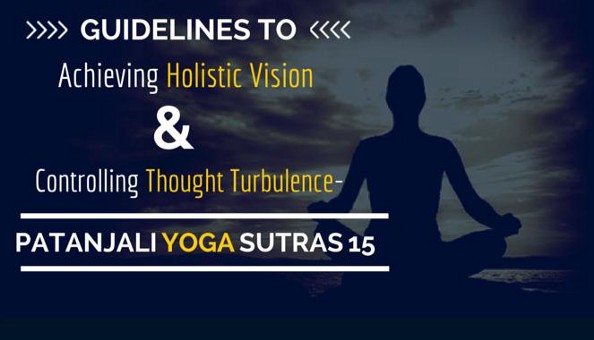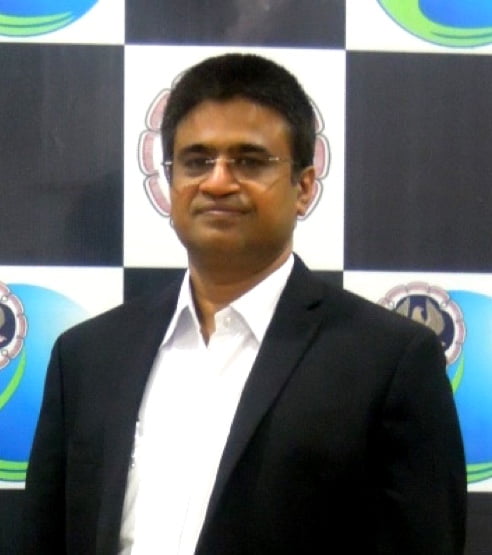In my last post , we talked about embedding yoga into our psyche through disciplined practice. We discussed the latent power of yoga and learned how it can be rooted into our DNA system. In the next 5 sutras, Patanjali explains the process of restraining negative thoughts and generating positive thoughts. In this post, we will be discussing how to see things holistically, understand the temporary nature of thoughts, and remain undisturbed by them:
दृष्टानुश्रविकविषयवितृष्णस्य वशीकारसञ्ज्ञा वैराग्यम्॥१५॥
Drusta anusravika vishaya vitrushnasya
vashikara sangya vairagyam ||15||
Gradually increase the range of your vision (Dhrishti in Sanskrit). By practice, one can slowly and steadily increase the vision to see beyond the obvious and reach the stage where he can see holistically and understand the relative and transitory nature of the present thoughts and view the thoughts without getting mentally embroiled in the same.
As an intelligent being, you are always aware of the surroundings. The more expanded your awareness, the deeper will be your understanding of the world. Use Yoga to broaden the vision, in order to notice the subtle thought patterns. It helps to be conscious of not only the physical world but also of the mental world.
Taking an Example, with normal eye vision you can see a few crisscrossing lines on your palm. Now, if you look at the palm with a 10X magnifying glass, you will see a lot of thin lines, which were not visible to the naked eye before. Further, if the lens are replaced with more powerful 100X magnification, the dead cell grooves and hills in the palm can be viewed. Similarly, yogic vision is all about looking beyond and having a holistic view of things. The microscopic view of thoughts shows back drop thoughts, hidden agendas, negative thoughts and feelings not observed normally. Through slow and steady practice, Yoga helps to understand the thought forms taking shape in themselves.
To take it further, whatever you perceive is always interpreted by your mind on the basis of accumulated knowledge. That knowledge has been obtained from reading on the matter and various observations. Yogic vision teaches you to accept your knowledge as finite. It recommends to be open to new perspectives, which may question and disprove your existing knowledge. You are advised to look beyond all the information, beliefs and outlooks in your mind. Here it is important to understand that there is more to reality than meets the eye.
All the past knowledge of good and bad feelings is valid only till it is disproved by superior argument or understanding. Knowledge is always relative and endless and is not to be taken as permanent and absolute. Even all the five senses that help you enjoy the fulfillment of any desire are temporary. For instance, while you are truly enjoying the sandwich and coffee at starbucks, you do know that all this is temporary and relative. The senses of taste and ambience will pass and a new state of mind will get established slowly, seeking new avenues for the senses. Being aware of this is possible by practice.
Just
like the positive feeling above, there are reactionary negative
thoughts that are stronger, dislodging and need to be handled with
attention. For instance, thoughts of jealousy, hatred or anger should be
realized and accepted. Instead of reacting to them aggressively &
instantly, realize that these feelings are temporary and will pass. The
pounding of various thoughts is an endless process, which keeps turning
an individual from one feeling to another. Trying to repress or stop the
thoughts from occurring is futile; it is not the right approach
according to the Patanjali yoga Sutras.
As said in the above sutra,
the first step is to appreciate the desires that continuously arise from
things seen, heard or learnt. The next step is to understand that these
feelings and knowledge are not absolute and their life is temporary.
You need to see your desires and thoughts as a natural process and
accept them with grace and openness. It is strongly recommended that you
make no conclusive judgments on every single thought that arises. The
key is to forcefully act for fulfillment but at the same time remain
indifferent to the thoughts, whatever they be. In other words, it is a
state of balance where you neither renounce material things nor get
attached to them.
With small steps and routine practice, soon your mind will get used to staying involved as well as indifferent to the thoughts and resultant feelings. You will attain that peaceful state where your negative emotions can coexist in you with tranquility. You will not be disturbed by your anger, sadness or hatred. This can be understood by taking another example: When you are walking along the street, you normally do not pay attention to each and every random passer by and keep walking your way. Similarly, you are not compelled to get distracted by every single thought that arises. You should remain in the state of holistic view where thoughts are there but the effect it mitigated.
Living a Yogic life is not about being an ascetic. It is not about disowning or renouncing all the good things as has been explained by many modern preachers. Accepting the short life and the limitation of all those negative and positive feelings is the crux of Yogic vision. Taking cognizance of the thoughts as they are, both positive and negative, with all their traits and imperfections, is necessary.
Vairagya is another misunderstood term in the spiritual world when it comes to understanding Yoga. Contrary to popular belief, Vairagya is not about renouncing the objects, but about renouncing one’s attachment to the objects. Vairagyam here means looking beyond and realizing the transient nature of the joy or satisfaction derived from the object, which will pass away in a while. Such an introspective vision is developed by yoga practice.
To sum up, detached attachment is the skill to be achieved by the practitioner of yoga in a scientific phased manner. The detached attachment has to be embodied within the mind through practice. It means you should be able to truly enjoy the things seen, heard and felt without being addicted to them. This is one of the core parameters that defines the level of success a person has achieved in the Yogic world. This is among the most important yoga lessons that every Yoga Enthusiast must learn and adopt.
It took me over 6 weeks of research, reading and thinking and more thinking to get this piece done. I would still love to delve more into these phrases. I find it amazing to notice that gaining control over the thoughts was so easy. If only you learn to look at things in a proper perspective. To attain the Yogic bliss, you just need to have a holistic view. In the next post, we will discuss more on the process of overcoming strife in life through yoga.

